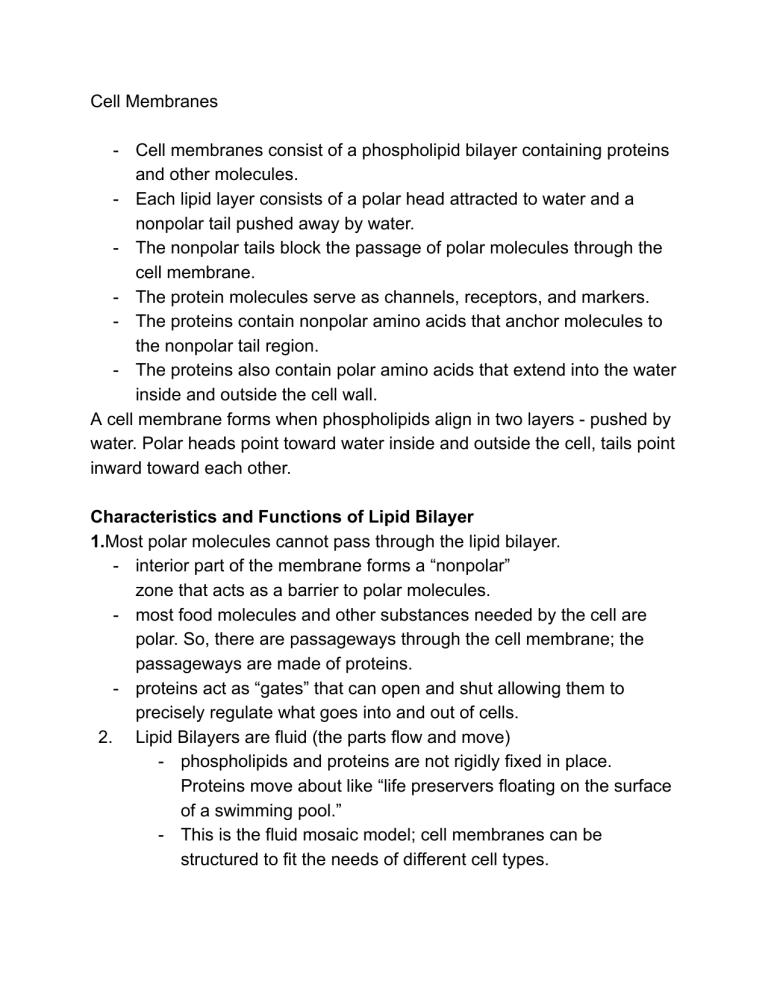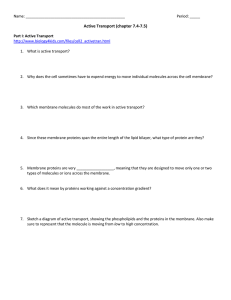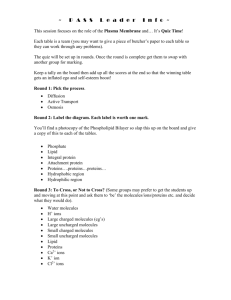
Cell Membranes - Cell membranes consist of a phospholipid bilayer containing proteins and other molecules. - Each lipid layer consists of a polar head attracted to water and a nonpolar tail pushed away by water. - The nonpolar tails block the passage of polar molecules through the cell membrane. - The protein molecules serve as channels, receptors, and markers. - The proteins contain nonpolar amino acids that anchor molecules to the nonpolar tail region. - The proteins also contain polar amino acids that extend into the water inside and outside the cell wall. A cell membrane forms when phospholipids align in two layers - pushed by water. Polar heads point toward water inside and outside the cell, tails point inward toward each other. Characteristics and Functions of Lipid Bilayer 1.Most polar molecules cannot pass through the lipid bilayer. - interior part of the membrane forms a “nonpolar” zone that acts as a barrier to polar molecules. - most food molecules and other substances needed by the cell are polar. So, there are passageways through the cell membrane; the passageways are made of proteins. - proteins act as “gates” that can open and shut allowing them to precisely regulate what goes into and out of cells. 2. Lipid Bilayers are fluid (the parts flow and move) - phospholipids and proteins are not rigidly fixed in place. Proteins move about like “life preservers floating on the surface of a swimming pool.” - This is the fluid mosaic model; cell membranes can be structured to fit the needs of different cell types. - Proteins that protrude from the cell membrane may serve as channels, receptors, or markers. a. Channel Proteins; proteins arranged into a shape like a doughnut form channels through the cell membrane. i. many molecules and ions needed by the cell cross through these channel proteins. However, each channel is like a locked door, only certain molecules will be admitted by each channel protein. b. Receptor Proteins are shaped like boulders. i. Receptors convey information from outside the cell to inside the cell. ii. The end of the receptor that sticks out from the surface has a special 3-D shape that holds (receives) a particular type of molecule. iii. When a molecule of the right shape fits into the receptor, it causes changes at the inside end of the receptor protein, which in turn, triggers responses inside the cell. c. Marker Proteins are elongated proteins that often have carbohydrates on their surface. These protein markers are the “nametags” of the cell. i. They identify your cells as being your own. ii. They organize cells to form tissues. iii. They tell cells where to go and which cells to join. iv. Marker proteins are characterized by two polar ends and a non- polar mid-section which is anchored into the cell membrane. How Cells Receive Information - Some cells have protein channels that are sensitive to electricity known as “voltage sensitive channels” - Almost all cells can sense chemical signals by means of receptor proteins protruding through their membranes. The end of the protein outside the cell has a unique shape- when the right molecule binds to the receptor protein, changes are triggered in the protein that are detected within the cell. - The signaling molecule does not enter the cell, just the information is transmitted. - It is like a tv antenna- they capture signals and deliver information. - Hormones are chemical substances that act as a messenger. Insulin is produced in response to high levels of sugar in blood; insulin binds to proteins that have the correct receptors and in response it causes changes to the cell so it takes up the sugar from the blood. If cells have too few insulin receptors, diabetes may result. Marker Proteins Just as a football jersey bears a number and last name, cells carry markers for identification. Every cell in your body contains a unique set of membrane proteins called cell surface markers. Your immune system recognizes your cells and can distinguish them from damaging invaders, such as harmful bacteria. Cell surface markers also indicate cell type- a blood cell, muscle cell, liver cell, etc. Uniqueness of cell surface markers explains why organ donors and recipients must be carefully matched. The donor and recipient must share many of the same identifying proteins on their cell surfaces. Cell surface markers are genetically determined, so if donor and recipient are genetically related there is a greater probability of a match. A perfect match never occurs, except between identical twins. The organ recipient must take immune suppressing drugs, for life, so their immune system won’t attack (reject) the transplanted organ. Moving into and out of the cell. Osmosis and Diffusion Diffusion is the mixing of two substances by random motion. Molecules diffuse from an area of higher concentration to an area of lower concentration. Osmosis is the movement of water across a cell membrane from an area of higher concentration (higher osmotic pressure) to an area of lower concentration (lower osmotic pressure). Selective Transport Many substances cannot easily pass through the cell membrane because of the nonpolar region in the middle, so polar molecules and ions use channel proteins to move in and out of the cell. -The transport of substances through membrane protein channels is called selective transport. “Selective” because each kind of channel will allow only a particular type of molecule or ion to pass through the membrane. Two types of selective transport: 1. Facilitated Diffusion -channels are like open doors, as long as the molecule or ion fits into the channel, it is free to pass through in either direction. It diffuses from higher to lower concentration. Because the passage of ions/molecules is assisted by the protein channels it is called facilitated diffusion. -Moving molecules down a concentration gradient, requires no energy input by the cell. 2. Active Transport - moves molecules in one direction (like turnstyles in a subway). - ”Active” transport requires energy as molecules are moved against a concentration gradient, or changes in the channel protein’s shape take place. - This process can stockpile substances in far greater concentrations than they occur outside the cell. - Almost all of the active transport in cells is carried out by only two kinds of channels, the Sodium Potassium Pump and the Proton Pump. A. Sodium Potassium Pump a. Sodium and potassium are two ions that are needed for proper nerve conduction. Uniquely shaped receptor sites on protein channels enable the ions to move in one direction only. Sodium ions are pumped out and potassium ions are pumped in. b. In one second, each channel can move more than 300 sodium ions out of the cell. About ⅓ of the cells energy is used on driving the sodium-potassium pump. c. When there are very few sodium ions in the cell, facilitated diffusion channels enable sodium ions to rush back into the cell. i. The channels must be opened by electrical currents or some of the ions are paired with a partner molecule such as sugar or an amino acid and pass through a channel protein called a coupled channel. B. Proton Pump a. A proton pump uses energy to pump protons (H+), usually from water, across membranes. This process depends on chemical or light energy. i. A proton pump expels protons until large numbers of protons build up outside a membrane. ii. Protons can diffuse back in again only through certain channels. b. This process is key to Photosynthesis c. This process helps transform energy from food to ATP, the form of energy your cells can use. Bulk Transport Endocytosis and Exocytosis Cells sometimes need to take in substances that are too big to pass through the protein channels in the cell membrane. - Some cells take in food particles by extending their cell membranes out toward the particle and surrounding it. When the edges of the membrane meet and fuse together, the particle is captured within a sac inside the cell. This process is called endocytosis. - The reverse process of ridding the cell of material by discharging it from sacs at the cell surface is exocytosis. - There are three types of endocytosis: 1. Phagocytosis “cellular eating” - cell wraps a pseudopodia around a solid particle and brings it into the cell. 2. Pinocytosis “ cellular drinking” - cell takes in liquid droplets by endocytosis. 3. Receptor mediated endocytosis - certain substances (called ligands) bind to specific receptors located in pits on the cell’s surface, causing a vesicle to form around the substance and then pinch off into the cytoplasm. Cell transport processes that do not require energy: Diffusion Osmosis Facilitated Diffusion Cell transport processes that require energy: Active transport - sodium/potassium ion pump - proton pump - Bulk transport (endocytosis and exocytosis) Diagram Labeling Word Bank Choices for the Roman Numeral Headings Channel Proteins Cell Surface Markers (Marker Proteins) Bulk Transport Receptor Proteins Sodium/Potassium Ion Pump Proton Pump Choices for numbered captions that explain each diagram a. Along the cell membranes, the concentration of ions are balanced. The voltage sensitive channels remain closed. b. An insulin molecule has a specific shape that fits into a receptor protein. Like a lock and key, the insulin molecule joins with the receptor protein. c. When additional ions upset the balance, the voltage sensitive channels spring open and ions pass through. d. The receptor protein changes shape sending a message to take in and store excess sugar. e. Sodium ions within the cell fit precisely into receptor sites on the channel protein. f. The sodium ions are released and cannot reenter through this channel. At the same time, potassium ions are pumped across the channel into the cell. g. Potassium ions enter the cell. Sodium ions outside the cell, along with sugar molecules reenter the cell through a coupled channel. h. The channel changes shape, pumping the sodium ions across the membrane. Potassium ions outside the cell move into receptor sites. i. In cotransport, an ATP pump that transports a specific solute indirectly drives the active transport of other substances. In this process, the substance that was initially pumped across the membrane (a H+ pumped by a proton pump for example) can do work as it moves back across the membrane by diffusion and it brings with it a second molecule (like sucrose) against its concentration gradient. This is analogous to pumping water uphill and performs work as flows back down. j. The cell membrane extends to engulf large particles in the process of endocytosis. k. Certain substances (ligands) bind to receptors in coated pits on the cell membrane, which causes vesicles to form around the substances and pinch off into the cytoplasm. l. Cellular wastes are discharged from sacs at the cell’s surface in the process of exocytosis.





